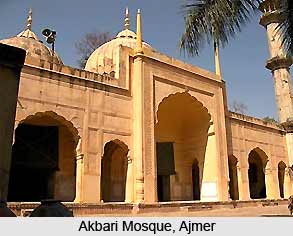 Akbari Mosque is located in the Dargah Sharif, a Sufi shrine in devotion to revered Sufi saint Khwaja Gharib Nawaz Moinuddin Chishti in Ajmer, Rajasthan. It was constructed by the Mughal emperor Akbar, who had come to Ajmer from Agra and offered prayers for an heir at the Dargah. In 1570 AD, six months after the birth of his son Prince Salim, who later became the Mughal emperor Jahangir, Akbar revisited Ajmer and ordered the construction of a mosque at the Dargah. He laid the foundation of the mosque with a
"khanqah", i.e., monastery, thus initiating its construction which was completed in 1571 AD.
Akbari Mosque is located in the Dargah Sharif, a Sufi shrine in devotion to revered Sufi saint Khwaja Gharib Nawaz Moinuddin Chishti in Ajmer, Rajasthan. It was constructed by the Mughal emperor Akbar, who had come to Ajmer from Agra and offered prayers for an heir at the Dargah. In 1570 AD, six months after the birth of his son Prince Salim, who later became the Mughal emperor Jahangir, Akbar revisited Ajmer and ordered the construction of a mosque at the Dargah. He laid the foundation of the mosque with a
"khanqah", i.e., monastery, thus initiating its construction which was completed in 1571 AD.
Architecture of Akbari Mosque
The Akbari Mosque is a huge structure constructed in red sandstone, on a square plot that measures 140 X 140 square feet. Its central arch is 56 feet high, facing the eastern side. The magnificent mosque and its east façade in white marble inlaid in geometric patterns bears resemblance with the famous gateway of the Jama Masjid at Fatehpur Sikri. Modest sized minarets adorn the beauty of the mosque. Its enormous arches are made of marble and are inlaid with lapis lazuli and enamel. Coloured stone bands frame the recessed large entrance arch and its spandrels. The courtyard is entered through a large gate and the interior walls of the compound are used today as a "madrasa", probably a continuation of their original function. The facade of the mosque`s prayer chamber has a high arched "pishtaq", appearing a more polished version of the entrance to Humayun"s mosque at Kachhpura in Agra, while the plan of the prayer chamber also resembles with that of the Kachhpura mosque.
A "hauz" (tank) for the purpose of "wazoo" (ablution) had been constructed in the centre of the vast quadrangle of the mosque. It was, however, closed and covered owing to certain reasons. The southern and eastern parts of the mosque have been transformed into cells and are now utilised as store rooms. The northern part of the quadrangle is intact. It is now the Moiniua Usmania Darul-Uloom, an Arabic and Persian School for religious education to the children. The historical monument, now made up of green and white marbles, is used for daily prayers. The interior part of the mosque exposes the style and architectural patterns of the imperial period, for example the net pendentives that appeared on Humayun"s mosque in Kachhpura and the "hammams" in Fatehpur Sikri. The Akbari Mosque manifests the Timurid pattern of architecture at the centre.
Related Articles:
Monuments in Ajmer
Khwaja Moinuddin Chishti
Dargah Sharif
Sufism
Sufi Saints
Ajmer
Places of Interest in Ajmer, Rajasthan
Akbar
Jahangir
Mosques in India
Jama Masjid
Humayun



















